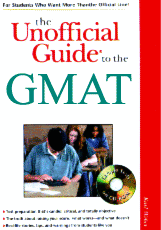| Do you need to take the
GMAT? What does the GMAT test? How does one register to take the GMAT exam? How is the GMAT scored? General tips for the GMAT The Analytical Writing section The Quantitative section The Verbal section How Can You Prepare For The GMAT? GMAT Frequently Asked Questions |
|
|
The GMAT is now a CAT test presented on a computer and this changes the scoring procedures slightly. At the end of the test you will be asked if you want to receive your scores or cancel them. If you cancel them you will not find out how you did and the business schools you apply to will be notified that you took the test on this date and cancelled your scores. The GMAT is scored in two parts and if you decide to receive your scores you will get part of your score immediately and part of your score a few weeks later Firstly, your essays from the Analytical Writing section will receive a score on a scale of 1-6 where 1 is the lowest score and 6 is the highest. The essays are sent to ETS after you take your test and are marked by a combination of human essay scorers and the ETS's computer essay scorer. For more details on the computer marker see Business Weeks article 'This Is E-Rater. It'll Be Scoring Your Essay Today'. The essays will take about two weeks to be scored. Secondly and most importantly you will receive a score from 200 to 800 which is for the quantitative and verbal sections of the test. This score is calculated by computer and is available, should you want it, immediately after you take the GMAT. The median score is 500 i.e. 50% of test takers score more than 500 and 50% less than 500. You will also receive a break down of your scores in both the verbal and quantitative sections. Scores for the sections will be in the form of a raw score and a percentile. The percentile tells you what percentage of test takers scored less than you in the the area, e.g. a percentile of 63% means that you did as well as or better than 63% of people who have presented the GMAT. The GMAT CAT The computer GMAT is a CAT (Computer Adaptive Test). This means that the difficulty of the questions you are given depends on how well you have answered previous questions. Basically if you do well and get the questions right you will be given increasingly difficult questions and if you get a question wrong the computer will react by giving you an easier question. This means that you will have a different test from the one taken by the poor soul sitting beside you taking the GMAT at the same time. Initial questions will be randomly chosen from mid level questions and then it will all depend on how you answer. You do not have to get all the questions right to get a perfect score of 800, in fact the questions should be difficult enough to cause you problems by the end of the test even if you are scoring 800. This makes a number of difference to your strategy for the test. Firstly, you cannot miss out difficult questions when you first see them and return to them later in the test. Secondly, the score you receive in the verbal and quantitative sections is not just a simple measure of how many questions you got right and how many you got wrong, it depends on which questions you got right and which ones wrong. The CAT tries to home in on the score you deserve and so at the beginning of the test right and wrong answers make big differences to your score whereas at the end of the test the CAT is just fine tuning your score and the changes are much smaller. Also you must attempt 80% of the questions because otherwise you are heavily penalised for not finishing enough questions for the CAT to assess you properly. |
  |
|
|
|
|
Do you need to take the
GMAT? |
GMAT and Graduate Management Admission Test are registered trademarks of the Graduate Management Admission Council (GMAC). ETS, GRE and TOEFL are a registered trademarks of the Educational Testing Service. GMAC and ETS are unaffiliated with and do not endorse this website or its contents. All other trademarks are the sole property of their respective owners. |